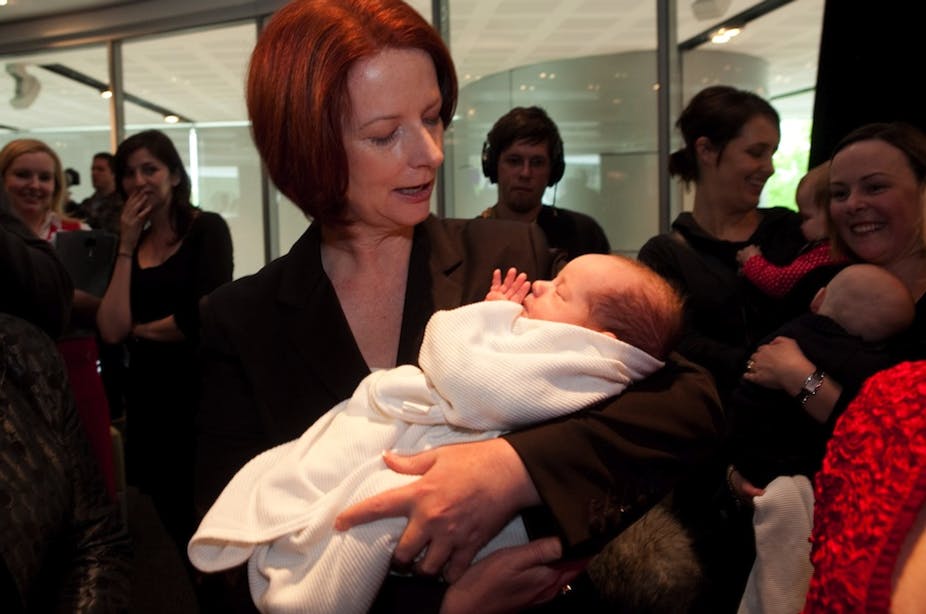Although the introduction of the baby bonus in 2004 was designed to provide financial assistance to families, a clear pro-natalist intent was also apparent.
Treasurer Peter Costello’s quip is now famous: “If you can have children it’s a good thing to do - you should have one for the father, one for the mother and one for the country, if you want to fix the ageing demographic”.
Now the Gillard government has announced the baby bonus will be cut back by $400 from next September.
So did the baby bonus affect the birth rate? And would the abolition of this benefit have much effect? The answer to both is a resounding no.
Australia’s total fertility rate rose from 1.76 births per woman at the introduction of the baby bonus to 1.96 in 2008, before falling back to 1.89 in 2010. However, the beginning of the upward trend in the birth rate in 2001 predates this policy initiative. Most (79%) of the increase between 2004 and 2008 can be accounted for by increases in fertility rates among women aged over 30.

Following the introduction of the baby bonus, birth rates for women under 30 initially decreased, then increased between 2006 and 2008, before falling back to pre-baby bonus levels in 2010. Australia’s increase in fertility has coincided with broadly similar patterns in the United Kingdom, Ireland and New Zealand. France, the Scandinavian countries and much of southern, central and eastern Europe also have experienced increases.
My research (with Ross Guest from Griffith University), recently published in the journal Demographic Research, shows the baby bonus and the other changes to family benefits contributed only a very minor increase to fertility rates.
Instead the evidence points to the influence of combination of demographic and economic changes.
One of these is the legacy of the past trend of postponing childbirth to later ages. Put simply, past decreases in fertility rates were exaggerated by the effects of fertility postponement, and more recently a replacement of previously postponed births has pushed the birth rate back up.
The prevailing strength of the economy also has contributed to the fertility rate increase (whether post GFC changes can explain the post-2008 fall in fertility is an intriguing question).
As well as increases to family benefits, the two main policy levers by which governments may attempt to increase birth rates are increasing assistance with child care costs and increasing parental leave. Given that the annual maximum payment is currently $7,500 and that its receipts to parents will cumulate over the child care using ages, the effect on birth rates of the child care rebate, introduced in 2005, has attracted surprisingly little attention.

The steepening of the fertility rate increase between 2006 and 2008 would appear to fit better with the plopping of child care rebate cheques into bank accounts than with the introduction of the baby bonus. My joint research with Professor Guest suggests the effect of the child care rebate on fertility probably has been greater than that of the baby bonus.
Clearly it is far too soon to assess what effect on fertility, if any, the introduction of the Government’s Paid Parental Leave Scheme in January this year has had. According to a review of the international literature by Anne Gauthier, some studies have found a small positive impact of such policies on fertility, and others no effect at all.
Costello’s playful “lie back and think of the ageing population” justification for introducing the baby bonus does raise the question of which birth rate and population growth trajectory is the best for Australia. This is a complex philosophical question requiring definition of what “population wellbeing” means.
Is it narrowly economically-defined or should wider environmental and social considerations be included? Whose “wellbeing’ should be considered? Is it just those people currently alive and in Australia or should consideration extend to future generations to come, or even to species other than humans? And how should we measure and weigh-up the complex effects of population change on "population wellbeing”?
The quote from Costello suggests concern over the effects of population ageing, a process which would be slowed if birth rates were to increase. However higher birth rates also increase population growth, and thus may fuel urban congestion, biodiversity loss, and carbon emissions.
The current fertility rate may be seen as consistent with a relatively satisfactory balance between the competing goals of maintaining a manageable population age structure and a manageable growth rate. In view of the very limited effects of public policies, in any case, those who see the birth rate level as undesirable will have to lump it.
The arrival of children leads to new financial pressures and an increased value to parents of time away from work. Since the demographic effects of either increasing or decreasing it will be negligible, it is the non-demographic arguments which justify maintaining the baby bonus.

